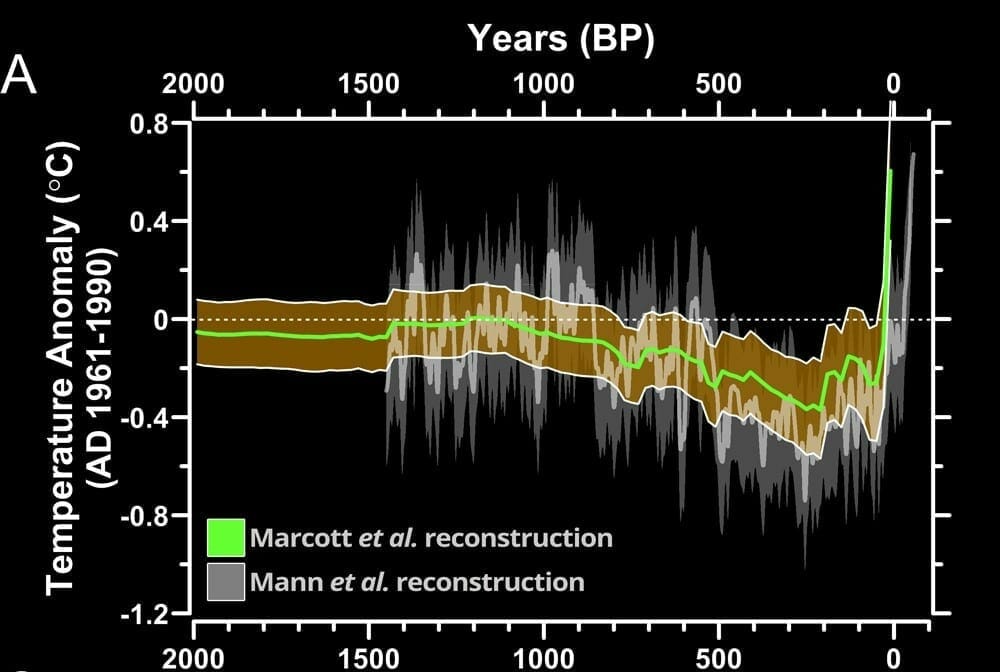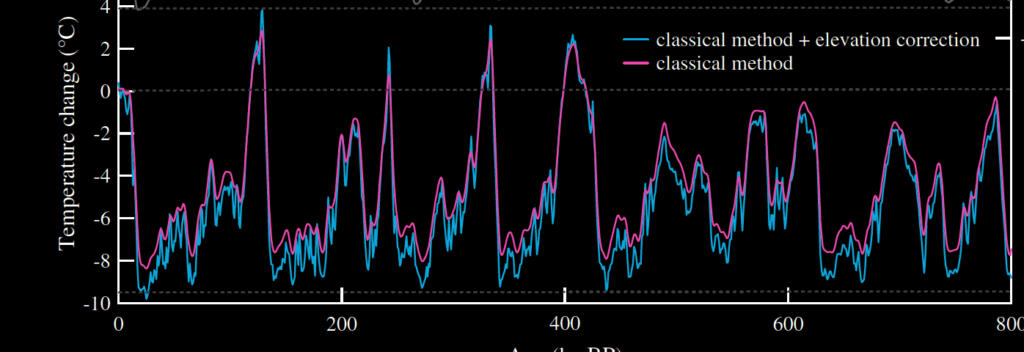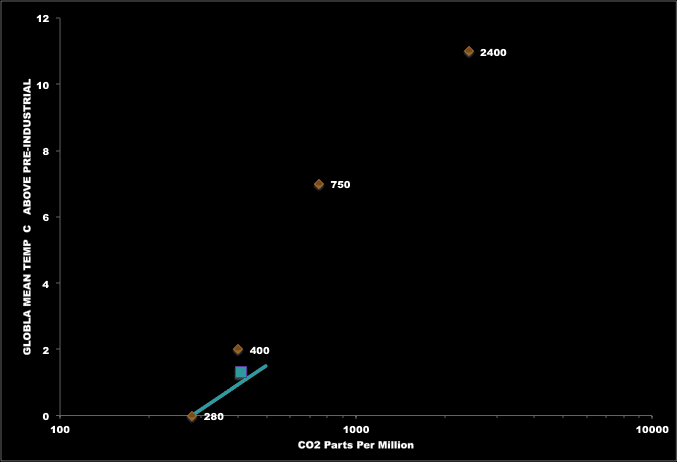Climate Change
An introduction to a complex field
By Eric J. Lerner, LPPFusion Chief Scientist
Some things about global climate change are clear, with good scientific evidence, but much is not yet known, mainly because the earth’s climate system is so complex.
Global warming is real
There is good evidence that since about 1975, the earth has warmed up on average around 0.9 °C (1.6 degree F). This is certainly comparable to, and possibly larger than, the biggest short-term fluctuations in climate that have occurred over the past several thousand years.

Figure 1. Global temperatures, last 2000 years. Rapid rise of 0.8 °C in last 50 years.
But this was a period of relative climatic stability after the end of the last Ice Age. By comparison, during the last Ice Age global temperature was about 8-10 °C lower than at present, a ten-fold larger shift.

Figure 2. Temperature from ice cores, last 800,000 years. Note much larger temperature scale — Ice Ages much colder than present. Also note time runs right to left here. Present is at left. Last 10,000 years of interglacial — warmer and stable weather.
Similarly, there is strong evidence that sea level has risen by about 10 cm over the same 40-year period. Again this seems to be larger than historical variations over at least the past 1,000 years. But it is tiny compared with the 150-meter rise that came with the end of the Ice Age.
The changes in the Arctic have been far more dramatic than global changes, with the summer extent of Arctic Ocean sea ice dropping rapidly by about 50%, starting in the late 1990’s. (Since sea ice floats, its melting does not contribute to sea level change.)
The longer-term trends, which include a much slower warming from the late 1880’s to around 1950, are complicated by the fact that the global climate was considerably cooler in the 18th century than the average for the past thousand years, so part or all of that early-20th century warming was due to a return to more normal temperatures.
The Sun has contributed, but that can’t explain it all
Over the past several decades, the Sun has been getting a little brighter, no doubt due to some solar cycle that will reverse in the future. NASA satellite measurements indicate the rate of brightening is now around 0.05% per decade. By itself, that would lead to a rate of temperature increase of about 0.04 °C per decade, about 20% of what has occurred in the past 45 years.
The Sun’s effect could be amplified in various ways. But we have some idea about that from the long-term variations in solar radiation falling on Earth that occur due to cyclical changes in the Earth’s orbit and the inclination of its axis. These changes over time scales of tens of thousands of years have led to the periodic Ice Ages that have occurred for the last two million years. The changes in solar radiation are about the right magnitude to create the huge shifts in climate, taking into account long-term amplification from the size of the giant continental ice sheets. So it is unlikely that, on time scales of just decades, the solar radiation changes could be amplified by anywhere near five-fold. While the Sun has contributed to global warming, there have to be additional causes.
Human Causes are Big Contributions
When it comes to causes, there are several possibilities. Carbon dioxide increases from fossil fuels is certainly the most popular one, but temperature increases do not closely track CO2 increases in recent decades, and in ancient data temperature increases may precede CO2 increases, according to some researchers.
However, CO2 increases do correlate with increases in temperature in the geological past, and by about the right amount to have caused recent warming. A 10% rise in CO2 has correlated with about a 0.5 °C rise in temperature in the past. Since the actual increase in this gas since 1975 is about 5% per decade, this could account for the whole rise of 0.2 °C per decade. So the impact of CO2 seems to be around six times more than that of the warming Sun.
But the case is complicated by the fact that, in the geological past, a CO2 increase could be caused by warming, rather than be the cause of it. As water warms, the solubility of CO2 decreases, so warmer oceans released huge amounts of CO2.

Figure 3. Based on chemical evidence in rocks, scientists can estimate both temperatures and CO2 abundance in previous geological epochs. Natural levels of CO2 of 400 PPM were reached in the Pliocene, 5 million years ago, before the period of recurrent Ice Ages. A level of 750 PPM occurred in the Oligocene, 30 million years ago, before the evolution of grassland allowed plants to pull CO2 levels much lower. Much higher levels of 2400 PPM existed 400 million years ago, in the Devonian, before the widespread development of animal life on land. In all cases higher CO2 levels are correlated with higher temperatures. The blue line shows a prediction from a detailed computer model that fits recent temperature and CO2 data. The blue square shows current conditions. At present rates of change, a level of 750 PPM would be reached in about a century, although the resulting temperature change is likely to be a lot less than that implied by the brown dots.
A second human contribution to global warming is the destruction of the tropical rain forests. This deforestation accelerated greatly around 1970 for economic reasons and led to the reduction of rainforest areas by about 30%. Since rainforests recycle moisture into the atmosphere, creating low-lying clouds, deforestation could have contributed significantly to the reduction in cloud cover and thus to the global temperature rise.
Temperature is very sensitive to cloud cover. Just a 0.6% decrease in cloud cover could by itself account for the 0.9 °C rise in global temperature. While cloud cover is really hard to measure accurately, some research indicates a decrease of as much as 1%. So the decrease in cloud cover, like the increase in CO2, can by itself account for 50% more warming than has actually occurred.
If rainforests contribute even 2% to global cloud cover, the 30% deforestation could alone account for all the global warming so far observed. Since 8% of the world’s rain falls on tropical rainforests, their contribution to global cloud cover is probably far more than 2%.
A third human warming effect is caused high-altitude aerosols, generated by airliners. These aerosols can be effective in preventing infrared radiation from escaping into space.
Fourth, soot from fossil fuel burning can settle on snow or ice-covered regions, making them darker and allowing them to absorb more solar radiation. In turn, more rapid melting of ice and snow, due in part to this soot darkening, uncovers much darker underlying land or ocean, increasing the warming effect. The amount of warming due to these last two causes is very hard to estimate.
Summary:
Global warming is real, although still small compared with big shifts like the end of the Ice Age. Human-caused processes—tropical deforestation and CO2 emissions—are the biggest known contributors to the warming since 1975. Soot and aircraft aerosols also cause warming. But the increased radiation of the sun has contributed substantially as well.
